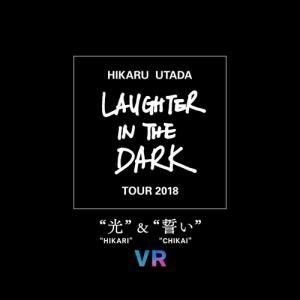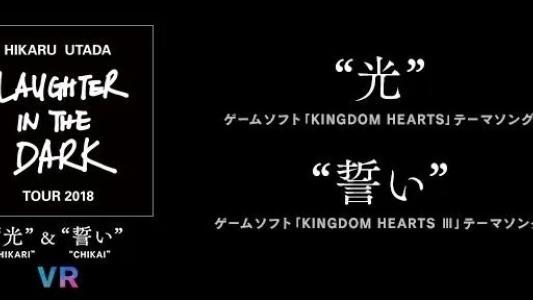
| Console: | Sony Playstation 4 |
| TV Standard: | Other |
| Release Date: | 2018-11-07 |
| Players: | 1 |
| Co-op: | No |
| ESRB: | Not Rated |
| Type: | Music, Utility, Virtual Console |


The VR experience of Hikaru Utada’s concert, “Hikaru Utada Laughter in the Dark Tour 2018 – ‘Hikari’ & ‘Chikai’ – VR” was filmed on Wednesday, November 7, at Yokohama Arena. The equipment for filming the VR scenes was brought in the day before, followed by elaborate rehearsals and the recording of two songs: “Simple and Clean” (the theme song of Kingdom Hearts) and “Don’t Think Twice” (the ending theme song of Kingdom Hearts III).
This VR experience makes you feel like you’re right there in the arena. You can see her perform the two songs from multiple angles; watch her singing enthusiastically right in front of you, or from further away, giving yourself a wider view of the whole venue.
In order to make the experience feel more real, three different cameras and shooting styles were used for recording both “Simple and Clean” and “Don’t Think Twice.” First, they shot with a 4K stereo/3D crane camera while approaching and backing away from the front. Then the same crane camera was used to film all around the left and right of Hikaru Utada. Finally, 6K · 180 degree cameras were used to shoot from far away, medium distance, and zoomed in at the same time. Every scene was shot with the latest equipment from Sony PCL.
These three shots were filmed separately and edited into one VR video later. Direction was handled by Robot Communications, a company that is famous for producing movies, TV commercials, music videos, and VR images. The director is Wataru Takeishi, who has been filming music videos and tours since Hikaru Utada was 16 years old.
After a final adjustment of equipment and one last sound and lighting check with the band members and string players, Hikaru Utada finally took the stage in a long black dress. They filmed “Simple And Clean” first.
Regarding effective movement in virtual reality, Director Takeishi explains: “As you approach the camera from a distance, the audience feels that Hikaru Utada is coming closer to them. When she’s looking at the camera, they will feel as if she is regarding them. As they reach out, they feel like she pops out toward them because of the spatial effect. I gave her this kind of advice about emotional movement in VR. ”
In “Simple And Clean,” there is one part where Hikaru Utada moves down the stairs to approach the front of the stage, and moves downwards and turns around. Before recording, the team confirmed that scene first and carefully checked the timing for her to start walking. After the timing and the speed of walking were decided, they were finally ready to go.
As filming began, the director donned the PlayStation VR headset underneath the stage. He checked how the image looked in PS VR in the same environment the user would experience. Almost 20 staff members concentrated on Hikaru Utada’s performance at once. They controlled crane cameras, checked the images with a VR headset, and watched the monitor.
However, things stopped as soon as they began. There was some discussion regarding when Hikaru Utada should sing the song’s chorus while looking at the camera, but the shooting would progress smoothly as long as they could decide when she should start walking. Filming with the first camera finished successfully in one take! The director attributes this to her wonderful facial expressions.
The shooting went well until the last scene, which was filmed with the high resolution 180 degree camera.
They filmed “Don’t Think Twice” next, after Hikaru Utada changed into a black-and-white dress. “Simple And Clean” was shot on the main stage, but this song would be filmed on the island stage in the center of the arena.
This song was also recorded from three angles with different cameras. The director advised her that it would look better if she adjusted her movements and the angle of her face. Since the score division of the song is very unique, her rhythmic gestures would look nice in VR.
This VR shoot adopted a one-cut method: when the song started, the camera would just keep moving around without cutting until the end. In other words, if something went wrong, the entire thing would need to be filmed from scratch instead of re-shooting from the middle. Nevertheless, Hikaru Utada’s concentration was rock-solid. She looked forward with overflowing emotion, her face dipping into shadow when she dropped her eyes. Even the filming crew had to take a breath to steady themselves from the shiver this performance evoked in them.
The final shot continued using the different cameras and was also finished in one take. The filming of both songs for VR wrapped after about two hours.



![Biohazard RE:2 [D Version]](https://gm.egamedb.com/biohazard-re-2-d-version-sony-playstation-4-fct.jpg)

![Visions of Mana [Collector's Edition]](https://gm.egamedb.com/visions-of-mana-collector-s-edition-sony-playstation-4-fct.jpg)
![UNDERNIGHT IN-BIRTH II [SYS:CELES] LIMITED EDITION (PS4)](https://gm.egamedb.com/undernight-in-birth-ii-sys-celes-limited-edition-ps4-sony-playstation-4-fct.jpg)


![Crown Trick [Limited Edition]](https://gm.egamedb.com/crown-trick-limited-edition-sony-playstation-4-fct.jpg)